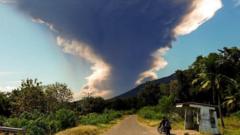The eruption at Mount Lewotobi Laki-laki has marked a significant escalation in volcanic activity on the island of Flores, sending an ash cloud soaring to 18 kilometers into the atmosphere. Since the eruption began on Monday morning, thousands of residents have been forced to leave their homes, though fortunately, no casualties have been reported. Authorities have raised the volcano's alert level to the highest status due to the increased activity, leading to the cancellation of at least 24 flights to and from Bali on Monday.
According to Muhammad Wafid, head of Indonesia’s geology agency, the eruption, which has produced the tallest plume since November, presents heightened risks, particularly to aviation. The initial eruption at 11:05 AM (03:05 GMT) unleashed a column of hot clouds and was followed by subsequent eruptions, including a powerful explosion at 7:30 PM and another at a reduced intensity early Tuesday morning.
Video footage circulated on social media displays the chaotic scenes as glowing lava flowed from the volcano’s peaks, with over 4,000 people evacuating in the chaos. Many residents who have remained are facing shortages of essential supplies such as water, food, and masks, heightening the emergency response needs in these communities.
Local leaders, including Paulus Sony Sang Tukan of Pululera village, raised alarms about the safety of water supplies contaminated by volcanic ash, emphasizing the critical need for ongoing assistance to those still in the vicinity of the volcano. He indicated that while water is still available, concerns over cleanliness are paramount given the volcanic fallout.
Resilient across the Ring of Fire, Indonesia remains susceptible to significant geological activity, a threat heightened by the recent eruptions of Lewotobi Laki-laki. Historically, the area has had devastating eruptions; one prior incident resulted in at least ten deaths, underscoring the dangers posed by it's volatile twin, also known as the "man" volcano, alongside the quieter Perempuan ("woman") peak.
With emergency operations underway, the community's urgent situation requires swift attention to uphold the health and safety of those affected by this natural disaster.
According to Muhammad Wafid, head of Indonesia’s geology agency, the eruption, which has produced the tallest plume since November, presents heightened risks, particularly to aviation. The initial eruption at 11:05 AM (03:05 GMT) unleashed a column of hot clouds and was followed by subsequent eruptions, including a powerful explosion at 7:30 PM and another at a reduced intensity early Tuesday morning.
Video footage circulated on social media displays the chaotic scenes as glowing lava flowed from the volcano’s peaks, with over 4,000 people evacuating in the chaos. Many residents who have remained are facing shortages of essential supplies such as water, food, and masks, heightening the emergency response needs in these communities.
Local leaders, including Paulus Sony Sang Tukan of Pululera village, raised alarms about the safety of water supplies contaminated by volcanic ash, emphasizing the critical need for ongoing assistance to those still in the vicinity of the volcano. He indicated that while water is still available, concerns over cleanliness are paramount given the volcanic fallout.
Resilient across the Ring of Fire, Indonesia remains susceptible to significant geological activity, a threat heightened by the recent eruptions of Lewotobi Laki-laki. Historically, the area has had devastating eruptions; one prior incident resulted in at least ten deaths, underscoring the dangers posed by it's volatile twin, also known as the "man" volcano, alongside the quieter Perempuan ("woman") peak.
With emergency operations underway, the community's urgent situation requires swift attention to uphold the health and safety of those affected by this natural disaster.



















